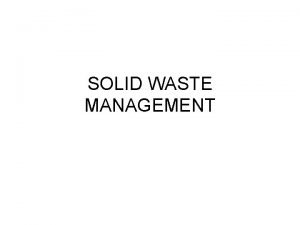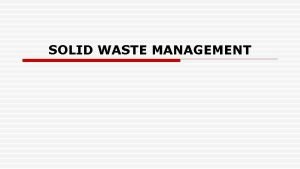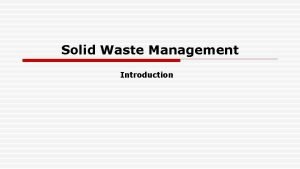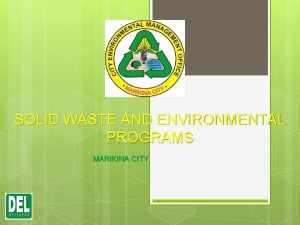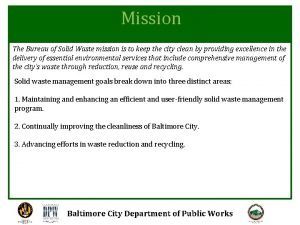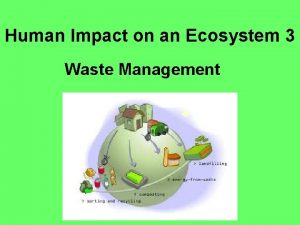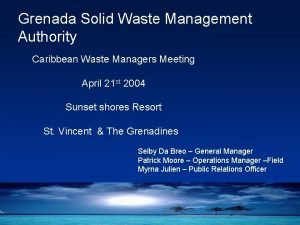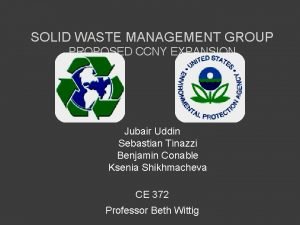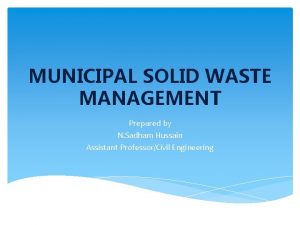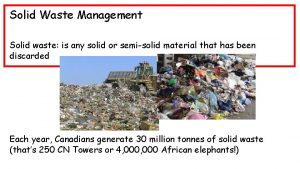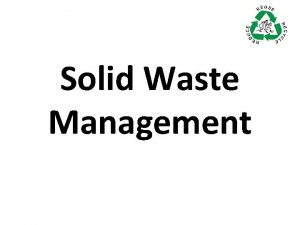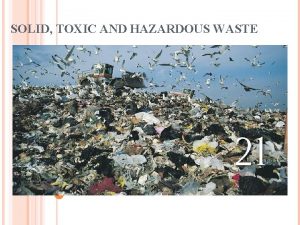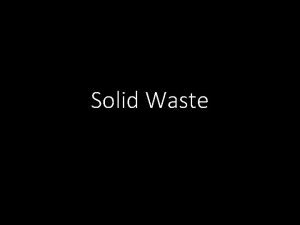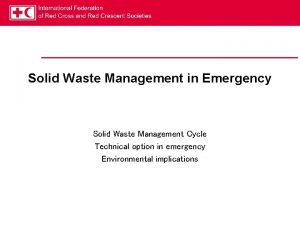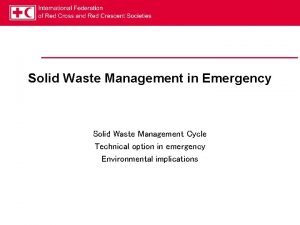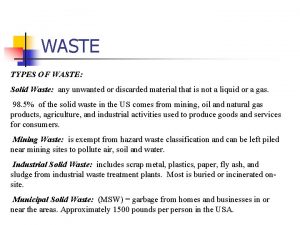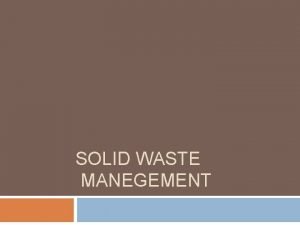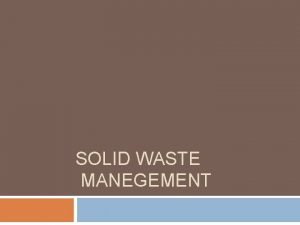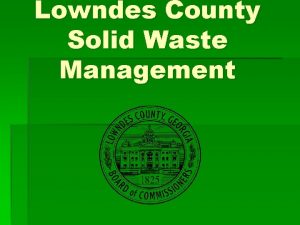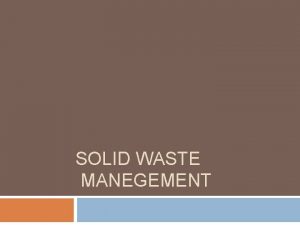Solid Waste Management Waste Definition Classification Any material





















- Slides: 21

Solid Waste Management

Waste- Definition & Classification Any material which is not needed by the owner, producer or processor. Classification • • • Domestic waste Factory waste Waste from oil factory E-waste Construction waste Agricultural waste Food processing waste Bio-medical waste Nuclear waste

Solid Waste

Classification of Wastes • Solid waste- vegetable waste, kitchen waste, household waste etc. • E-waste- discarded electronic devices like computer, TV, music systems etc. • Liquid waste- water used for different industries eg tanneries, distillaries, thermal power plants • Plastic waste- plastic bags, bottles, buckets etc. • Metal waste- unused metal sheet, metal scraps etc. • Nuclear waste- unused materials from nuclear power plants

Solid Waste in India • 7. 2 million tonnes of hazardous waste • One Sq km of additional landfill area every-year • Rs 1600 crore for treatment & disposal of these wastes • In addition to this industries discharge about 150 million tonnes of high volume low hazard waste every year, which is mostly dumped on open low lying land areas. Source: Estimate of Ministry of Environment & Forest

Growth of Solid Waste In India • Waste is growing by leaps & bounds • In 1981 -91, population of Mumbai increased from 8. 2 million to 12. 3 million • During the same period, municipal solid waste has grown from 3200 tonnes to 5355 tonne, an increase of 67% • Waste collection is very low for all Indian cities • City like Bangalore produces 2000 tonnes of waste per annum, the ever increasing waste has put pressure on hygienic condition of the city Source: The Energy & Resources Institute, New Delhi

Waste Collection in India • Primarily by the city municipality -No gradation of waste product eg bio-degradable, glasses, polybags, paper shreds etc -Dumps these wastes to the city outskirts • Local raddiwala / kabadiwala (Rag pickers) -Collecting small iron pieces by magnets -Collecting glass bottles -Collecting paper for recycling • MCD- Sophisticated DWM (Delhi Waste Management) vehicle

How solid waste affected us in recent years? • Cloudburst in Mumbai (2005) clogged the sewage line due to large no. of plastic bags • Blast in the Bhusan Steel factory at Noida, caused due to imported scrap from Iran • Reduction in the number of migratory birds due to consumption of contaminated foods • Stray animals dying on streets and farmland due to consumption of plastic bags, which blocks the food movement in their stomach

Hazardous / Toxic Waste & Dumping Site • Industrialised countries have waste management problems • Developed countries have strict environment regulation norms • Most attractive option for them- to dump into developing countries

Philadelphia’s Municipal Waste • 16 years journey for the cargo ship to eleven countries and four continents • 25, 000 tonnes of flyash came back to Philadelphia’s garbage dump • Several government refused cargo ships • In 2002, Cargo ship returned back to US

Major Polluting Industries in India • Around 2500 tanneries discharge 24 million cu m of waste water containing high level of dissolved solids and 4, 000 tonnes of hazardous solid waste • 300 distilleries discharge 26 million kilolitres of spend wash per year containing several pollutants • Thermal power plants discharge huge waste materials

Collection & Recycling of Waste Materials

Managing Waste Recycling: Processing of a waste item into usable forms. Benefits of recycling: -Reduce environmental degradation -Making money out of waste -Save energy that would have gone into waste handling & product manufacture Saving through recycling: -When Al is resmelted- considerable saving in cost -Making paper from waste saves 50% energy -Every tonne of recycled glass saves energy equivalent to 100 litres of oil

Recycling not a solution to all problems! Recycling is not a solution to managing every kind of waste material For many items recycling technologies are unavailable or unsafe In some cases, cost of recycling is too high.

Solution: More Profit With Zero Waste • Exchanging output that are considered waste • Waste of one could be input or raw material for others • Evolving a closed system- matter & energy circulate within • System was not designed to be so • The system of exchange evolved in 10 years

Problems in Dealing With Solid Waste • Education & voluntary compliance • Collection of waste • Technological interventions • Institutions & regulatory framework • Absence of mandatory standards for waste reduction • Market action for waste reduction Source: The Energy & Resources Institute

TERI Projections on Waste Generation In India

http: //www. greenpeace. org/international/news/ghost-ship-121205 French aircraft carrier Clemenceau

French aircraft carrier Clemenceau • December 12, 2005, Clemenceau, Ghost ship nobody wants • 27, 000 -ton warship full of asbestos, PCBs, lead, mercury, and other toxic chemicals • Indian scrapyard of Alang (Bhavnagar district, Gujarat) , a place where environmental regulations are lax and workers' rights are practically nonexistant • In most shipbreaking nations proper waste management is absent. There are no rules and regulations. And where rules exist, they're unlikely to be enforced. • Basel Convention (1989) is an international treaty which prohibits the export of hazardous waste from rich to poor countries • Greenpeace raised awareness campaigned against the ship in India as well as in France • French President Chirac has announced a dramatic recall of the asbestos-laden warship Clemenceau

References • Environmental Studies -R Rajagopalan • www. greenpeace. org • www. teri. res. in

Presentation By Group 13 • • Praful Ranjan Rajat Kumar Rakesh Panda Rohit Arya Roll No. -28 Roll No. -33 Roll No. -34 Roll No. -40
 Waste is any material that is not needed by the
Waste is any material that is not needed by the Material balance principle
Material balance principle Waste management definition
Waste management definition Solid
Solid Introduction to waste management
Introduction to waste management Marikina garbage segregation
Marikina garbage segregation Conclusion of solid waste management
Conclusion of solid waste management 3 waste disposal
3 waste disposal Types of transfer stations in solid waste management
Types of transfer stations in solid waste management Solid waste management
Solid waste management Grenada waste collection
Grenada waste collection Solid waste management
Solid waste management Solid waste management objectives
Solid waste management objectives Solid
Solid Waste disposal grenada
Waste disposal grenada There isn't any
There isn't any Any to any connectivity
Any to any connectivity Any question atau any questions
Any question atau any questions Chem
Chem Example of solution
Example of solution Covalent molecular and covalent network
Covalent molecular and covalent network Crystalline solid and amorphous solid
Crystalline solid and amorphous solid
